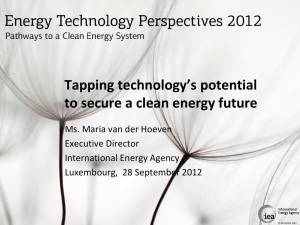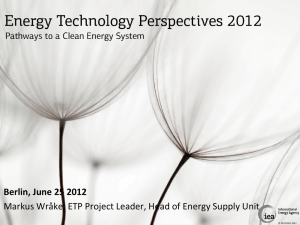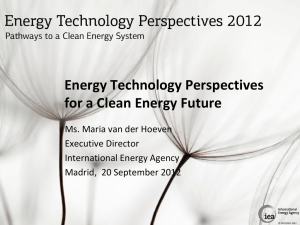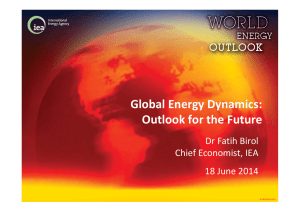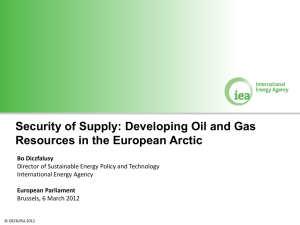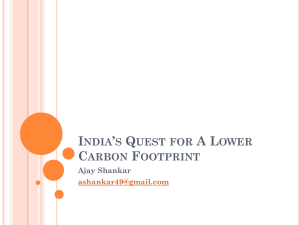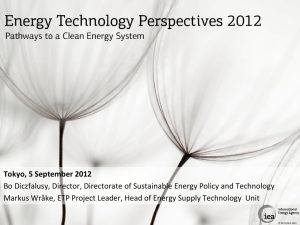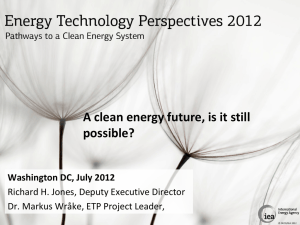Expected Outcomes of Workshops
advertisement
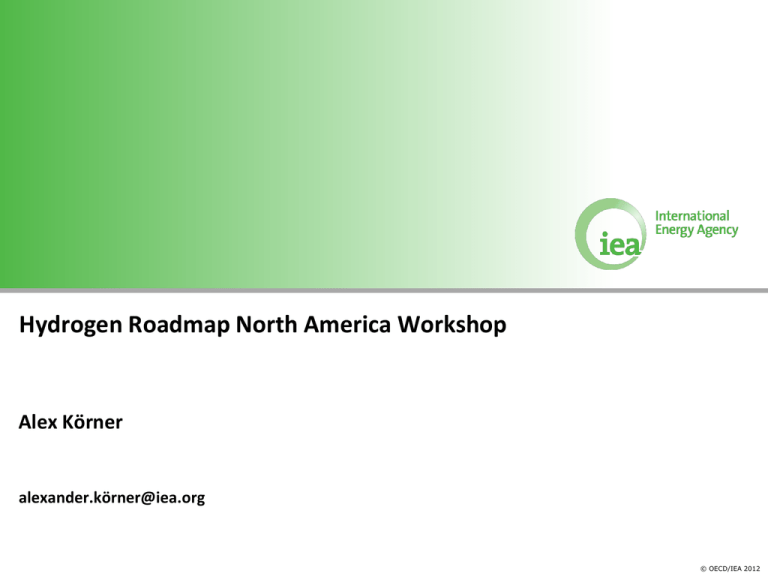
Hydrogen Roadmap North America Workshop Alex Körner alexander.körner@iea.org © OECD/IEA 2012 Content Roadmap outline: Scope – vision – structure Roadmap analytical capabilities: Modeling tools State of the art Literature review Input data validation – transport Preliminary results Expected outcomes of the workshop © OECD/IEA 2012 Structure and scope of the roadmap © OECD/IEA 2012 Outline of Roadmap Introduction Rationale for roadmap – H2 in the energy system Transport Stationary applications Energy storage Synergies between energy sectors Technology status today Vision for deployment to 2050 Technology development – Actions and milestones Policy, regulation, financing: Actions and milestones © OECD/IEA 2012 Rationale hydrogen Decarbonization of the energy system Power sector: Increased demand for operational flexibility creates demand for energy storage Transport sector: Increased demand for high energy density AND low carbon fuels puts pressure on biofuels and creates demand for alternatives Stationary: Increased demand for high efficient and integrated processes creates demand to use intersectoral synergies © OECD/IEA 2012 Key features of Hydrogen Potentially low carbon Very flexible energy carrier which can be generated from almost all PE to a suite of useful end-use energy carriers Can store energy At large scale over long time – Energy storage & VARres integration At small capacities under restricted space and weight requirements - Transport Can be used as feedstock to reduce carbon footprint Hydrogen is used in large quantities already today © OECD/IEA 2012 Key features of Hydrogen In the long term, hydrogen applications needs to built on: The use of low carbon hydrogen The need to store energy (either at larger quantities or in mobile applications) In the short term, existing infrastructure to generate and distribute hydrogen will have to play a great role to create hydrogen demand markets © OECD/IEA 2012 Technology status today Discussion of key technology components Electrolyzers, fuel cells and storage technology Discussion of demand side technologies Fuel cell vehicles Niche applications Fork lifts, UPS, micro FC CHP Hydrogen distribution, transmission and retail infrastructure Transmission technology – Gaseous and liquefied trucking, pipelines Hydrogen refueling stations © OECD/IEA 2012 Technology status today Hydrogen based flexibility options for the power sector Power – to – power Power – to gas Power – to – fuel Efficient steel making processes Blast furnace top-gas recovery with H2 separation and reinjection © OECD/IEA 2012 Regional focus The roadmap will contain global views on certain aspects – e.g. GHG potential of FCEVs in road transport Detailed analysis will focus on the following regions EU G4 USA Japan © OECD/IEA 2012 Vision – Transport What if 25% of all PLDVs are FCEVs by 2050? Vehicle sales and ramp-up rates Discussion of global fuel use and emission reduction potential Costs and benefits Infrastructure requirements and costs 2DS-high H2 Million vehicles 2 000 1 500 FCEV BEV 1 000 PHEV Hybrid ICE 500 0 2010 Conventional ICE 2020 2030 2040 2050 © OECD/IEA 2012 Vision – Hydrogen storage What if large scale hydrogen electricity storage can get competitive? Estimation of storage potentials in high VARres integration What costs/efficiencies needs to be reached for H2 electricity storage technology to be competitive © OECD/IEA 2012 Vision – Power-to-gas Can power-to-gas be a competitive flexibility option? At which carbon price power-to-gas can get competitive? Attempt to estimate regional storage potential within existing NG infrastructure under certain blend shares based on existing studies What techno-economic parameters of electrolyzers needs to be achieved? Source: Analyse des Klimaschutzpotentials der Nutzung von erneuerbarem Wasserstoff und Methan, DVGW 2013 © OECD/IEA 2012 Vision – Power-to-fuel What if otherwise curtailed electricity would be used to produce H2 for transport? Even under optimistic cost/efficiency assumptions of electrolyzers, low value electricity needs to be used to make renewable H2 competitive with e.g. NG steam reforming Can the inherent storage need for transport refueling infrastructure serve as a storage for VARres integration? Source: Renewable Electricity Futures Study, Volume 1, NREL 2013 © OECD/IEA 2012 Technology development – Actions and milestones Actions and milestones will be set based on the following metrics: Which cost targets needs to be met – benchmarking of H2 technologies Transport: TCO breakeven with gasoline hybrid ICEs Storage: LCOE breakeven with PHS, CAES By when cost targets needs to be met Based on FCEVs stock targets, stock turn over and sales ramp-up Based on power sector scenarios and variable renewable integration This roadmap recommends the following actions: Assess and catalogue potential PSH and CAES sites and estimated costs. For PSH, this assessment should include pump-back, off-stream, and closed-loop, land-based and marine potential. Assess potential and costs of transforming existing constant-speed pumped storage hydropower (PSH) into variable-speed, allowing these plants to provide additional ancillary services Complete retrofits on existing PSH facilities to improve total efficiency and flexibility. Improve storage efficiency of CAES systems to 70%, in particular through improvements in compression (turbine) efficiency and adiabatic CAES project development. Proposed timeline 2014-2020 2014-2020 2020-2035 2014-2035 © OECD/IEA 2012 Policy, regulation, financing – Actions and milestones FCEVs: Estimate of economic gap Effect of taxation of petroleum based transport fuels Quantification of direct subsidies Power – to – gas: Impact of carbon prizing H2 electricity storage: Discussion of current barriers – e.g. storage technologies frequently do not fit naturally into existing regulatory frameworks as they provide value across different portions of the market © OECD/IEA 2012 Analytical capabilities © OECD/IEA 2012 Overall ETP modelling framework Supply side: TIMES – Energy system least cost optimization model Demand side Split into three sectoral models: Transport (MoMo), Industry and Buildings All demand side models are technology rich stock accounting simulation tools which allow for sectoral projections of energy use, emissions and costs until 2050 © OECD/IEA 2012 ETP modelling framework Energy costs Primary energy Conversion sectors Final energy End-use sectors Electricity production Fossil Renewables Nuclear Refineries Synfuel plants CHP and heat plants Material demands Electricity Gasoline Diesel Natural gas Heat etc. etc. ETP-TIMES model End-use service demands Energy demand Industry Heating Cooling Buildings Passenger travel Transport Freight MoMo model etc. Model horizon: 2009-2050 (2075) in 5 year periods © OECD/IEA 2012 Hydrogen supply options Centralised hydrogen production Natural gas Heavy fuel oil Coal Biomass Nuclear Solar Electricity max. 10% Pyrolysis/ Gasifier/ Reformer with and without CCS Natural gas pipeline H2 distribution H2 pipeline Sulfur/Iodine cycle Electrolysis H2 storage Natural gas use H2 use in transport, industry, buildings, electricity generation, refining Decentralised hydrogen production Electricity Natural gas Natural gas Heavy fuel oil Electrolysis at fuel station H2 gas storage Reformer at fuel station LH2 storage Reformer/Gasifier at refinery H2 use in transport H2 use in refining © OECD/IEA 2012 ETP Mobility Model (MoMo) It is a spreadsheet model of global transport energy use, emissions, safety, and materials use analysis of a multiple set of scenarios, projections to 2050 Based on hypotheses on GDP and population growth, fuel economy, costs, travel demand, vehicle technology shares World divided in 29 regions, incl. a good number of specific countries USA, Canada, Mexico, Brazil, France, Germany, Italy, UK, Japan, Korea, China, India The model is suitable for handling regional and global issues It contains a large amount of data on technology and fuel pathways full evaluation of the life cycle GHG emissions cost estimates for new light duty vehicles estimates for fuels costs and fuel distribution infrastructure section on material requirements for LDV manufacturing It is based on the "ASIF" framework: Activity (passenger travel) * Structure (travel by mode, load factors) * Energy Intensity = Fuel use © OECD/IEA 2012 Vehicle stock in 2DS and variants 2DS passenger transport integrates technological and behavioural aspects: Avoid/Shift/Improve ETP 2012 discussed different technology portfolios with respect to energy use, emissions and costs based on varying the shares of FCEVs vs. PHEVs © OECD/IEA 2012 Fuel demand by scenario and fuel type To reach the emission target, in the 2DS energy use in the road transport sector needs to be reduced by almost 50% compared to the 4DS, going back to 2010 levels whilst vehicle stock is more than doubling The increased use of FCEVs can liberate more biofuels for use in other transport sectors © OECD/IEA 2012 State of the art © OECD/IEA 2012 Literature review Literature list see ETP 2012 Recently reviewed: NREL FCEV Demonstration Project FC stack lifetime seems main issue (2000h ~ 40,000 – 80,000km) FCH-JU/McKinsey bus study Leaves a lot of open questions with respect to results and methodology NREL Renewable Energy Futures Study Interesting levels of curtailment at various rates of variable renewable energy penetration: At 90% RES (~60% VARres) 140 TWh electricity are might be curtailed annually NAS - Transition to alternative vehicles and fuels “Fuel cells, batteries, biofuels, low-GHG production of hydrogen, carbon capture and storage, and vehicle efficiency should all be part of the current R&D strategy. It is unclear which options may emerge as the more promising and cost-effective.” © OECD/IEA 2012 Kick-off meeting and Europe WS On June 9/10 IEA hosted kick-off meeting and Europe WS in Paris Vehicle technology is mature, market is needed Strong need to built upon existing studies Strong desire to focus on qualitative analysis No common idea on infrastructure development nor how a “final” H2 T&D and retail system could look like Costs of renewable H2 are a major challenge for applications in all sectors - economical only with very low electricity costs Niche markets for electrolysers might emerge in the near future in the control power segment Careful classification and distinction between H2 energy storage applications and energy service © OECD/IEA 2012 Input data review In November we sent a compilation of input data for review to the Hydrogen Roadmap steering group The data contained assumptions on: FCEV Stock & sales Technology component cost and learning rates FCEV costs Vehicle fuel economy © OECD/IEA 2012 Preliminary results - FCEV costs 60 70 55 60 Gasoline ICE (USA) Gasoline HEV (USA) 50 45 40 40 30 35 20 30 25 10 20 0 2010 2020 2030 2040 2050 FCEV stock millions Thousand 2010 USD 50 Glider (USA) HEV global average MSRP in 2011 Gasoline HEV Plug-in (USA) Prius-PHV Diesel ICE (USA) Diesel HEV (USA) CNG/LPG (USA) H2 FCV (USA) BEV (USA) BEV global average MSRP in 2011 FCEV stock FCEV costs drop relatively quickly with sales if envisaged FC stack production costs can be achieved © OECD/IEA 2012 Total cost of driving Total cost of driving USD/km 0.40 70.00 60.00 0.35 50.00 0.30 40.00 FCEV ICE HEV 0.25 30.00 BEV 20.00 PHEV FCEV stock 0.20 10.00 0.15 2010 2020 2030 2040 0.00 2050 TCO drop slower due to H2 generation and T&D cost Based on TCO “economic gap” analysis can be conducted © OECD/IEA 2012 Million vehicles Thousand USD Example economic gap calculation 70 70% 60 60% 50 50% 40 40% 30 30% 20 20% 10 10% 0 0% -10 2010 2020 2030 2040 -20 2050 -10% FCEV stock millions "Subsidy" per vehicle sold, thousand USD/veh Annual share of "subsidy" on "tax" -20% 30% taxation of petroleum fuels TCO breakeven FCEV vs. hybrid around 2040 At 30% petroleum fuel taxation, annual FCEV „vehicle subsidy“ would peak at ~15% tax revenue © OECD/IEA 2012 Copper-plate storage potential 2DS Combination of long-term investment decision/least cost energy system run and dispatch model run with 2050 fixed ES fleet Storage results captures only time-wise mismatch between supply and demand © OECD/IEA 2012 Long-term H2 electricity storage LCOE USD/MWh 2500 2000 1500 1000 500 Seasonal Today Seasonal Future 0 300 MWel_out, 120h, 5 cycles/y LCOE highly senstive to: Set-up of storage & cycle rate Investment cost electrolyzer/fuel cell, efficiency fuel cell Break even with OCGT at ~300 USD/kW for FC if all other parameters fixed – Synergies with transport/large scale FC production? © OECD/IEA 2012 Short term H2 electricity storage 600 LCOE USD/MWh 500 400 Arbitrage Today 300 Arbitrage Future 200 100 0 H2 symetric PHS Electricity – to – electricity short term storage does not look very promising, even with optimistic cost assumptions © OECD/IEA 2012 Expectations & proceeding the workshop © OECD/IEA 2012 WS expectations & structure Agenda of the WS is very broad We will not have the time to go very much into technical detail Identification/prioritization of main technical/market related/policy related issues for H2 applications in North American context Mobile Stationary Storage Industry? Short presentations will start discussion in seven specific sessions © OECD/IEA 2012 Thanks! © OECD/IEA 2012
